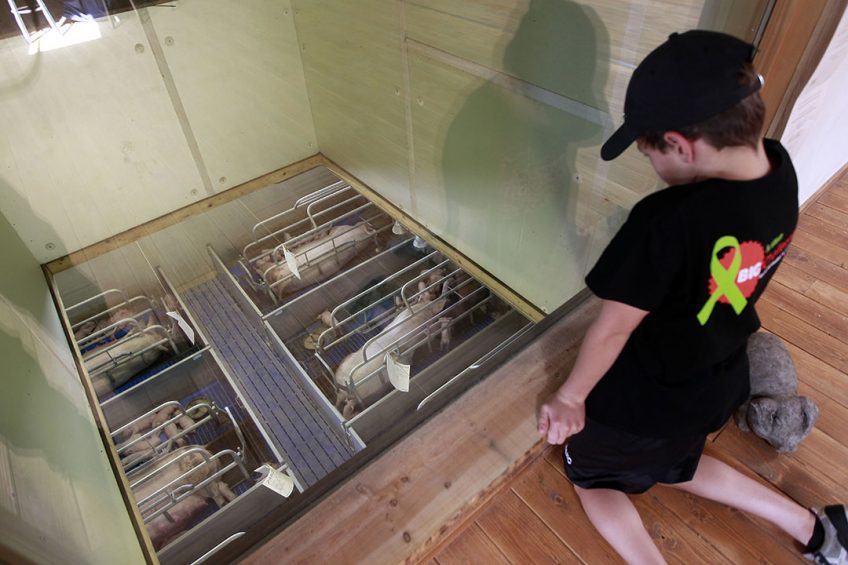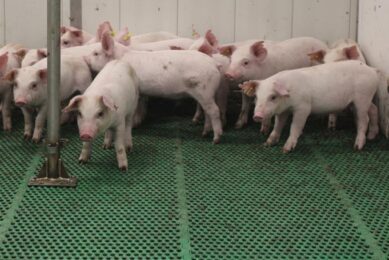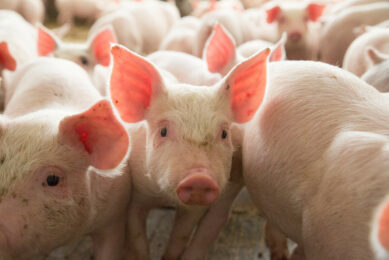Healthy pig production systems are sustainable

Over the years, the global swine industry has designed systems to keep pigs in. Now the question is – did the pigs have to adapt to the systems or were the systems designed to the pigs’ needs? The answer to that question can help to gain more insight how to make a farm healthier.
The World Organization for Animal Health (OIE) estimates that 20% of global food production is lost due to diseases in farmed animals. Therefore, health and welfare of animals is crucial for future sustainable production systems. When working with pig health it is very important to consider the epidemiological triad of disease, where disease is always a consequence of the 3 factors:
- the pig,
- the environment and
- the disease-causing agent.
Increasing demands on pig welfare
There are increasing demands on pig welfare, high quality products, low antimicrobial use, environmentally sustainable systems, openness and traceability in pig production. Pig meat producers are facing huge challenges to meet consumer expectations that cannot be met a lot of time in the current market and production systems.
To meet current consumer demands and future sustainability goals it is necessary to have a higher level of pig health, improved husbandry, increased productivity and ultimately a globally responsible and sustainable system. Improvements in pig environment, management and nutrition enhance health and welfare, while productivity increase. Therefore, investments in pig health and welfare are cost-effective and furthermore they improve the welfare of those working with the pigs.
There are numerous health challenges facing the industrialised pig production these days. Every farm has a combination of challenges to their pigs’ health and welfare and the diseases present are usually linked to the weaknesses of the production system. As the industry has attempted to improve productivity and efficiency of pig production systems, often systems were not adapted to the needs of the pigs. Rather, the industry tried to adapt the pigs to the systems.
Endemic diseases in pig farms
The result has been various diseases have become endemic in pig farms. It is very important to identify the risk factors for the diseases present on the farm and focus on those, rather than just medicating or vaccinating the animals. Medicines such as antibiotics, anticoccidials and vaccines are valuable tools that can immediately assist a farmer to optimise the health of the pigs. However, these veterinary treatments should not be the sole permanent solutions without considering the risks for disease found in husbandry, environment and feed. The saying ‘prevention is better than cure’ is often embraced, but the implementation of this saying on the farm is many times still lacking.
It is common to focus on one or several diseases when trying to optimise the pig health on a farm. It is important to quickly determine what major disease agent is suppressing health in the pigs and treat it. However, once the symptoms have subsided, it is way too easy to simply just continue as previously, with possibly, another treatment included in the standard protocols. This is likely the strategy that had led the industry into the antibiotic overuse situation that is now threatening the efficacy of our antibiotics for future generations of humans and animals. After treatment, it is necessary to move on and address the risk factors, that could be management, environment or nutrition, that made the animals succumb to disease.
That is the most important step to create ‘Healthy production’. The global goal to reduce antimicrobial use in animal production will thereby assist the whole pig industry to optimise animal health and welfare through proper environment, husbandry and feed, and thereby the whole sector will benefit. This will lead to higher level of pig health, increased productivity, and ultimately a globally responsible and sustainable system.

Biosecurity
Biosecurity is critical in preventing the introduction of disease-causing organisms on a farm and prevent the spread within a farm. Higher levels of biosecurity in pig farms has been shown to be associated with higher levels of production, and decreased antimicrobial use and resistance. Most pig farms need to focus on improving internal biosecurity, since the major challenges for the farms’ health are already found in the pigs, and thereby internal biosecurity can reduce the spread and impact. ‘Internal biosecurity’ has a larger impact on the everyday working routines than ‘external biosecurity’ and many farmers tend to ignore that they are collaborating with the disease-causing agent in spreading it around.
Immunity
A good developed immunity to various diseases is essential in industrial pig production. A good immunity in a piglet starts at birth, with good colostrum intake and nutrition. Vaccines have proven to be crucial and very cost-effective in preventing the onset and spread of infectious diseases and therefore crucial in the modern healthy production system. However, immune-enhancing measures are not limited to vaccinations but include numerous other factors such as genetic selection, pathogen-free animals, nutrition, immune-enhancing supplements, mycotoxin prevention, stress reduction, stocking density and environmental factors. It is essential that the animals live in a low stress environment with good nutrition to be able to effectively develop their disease defence. Supplementation of certain organic minerals, such as selenium (Sel-Plex), aid in the optimal functioning of the immune-system.
Gestating and lactating gilts and sows
It is imperative to respect the pig’s physiological and environmental needs, not only for welfare reasons and consumers demands, but also because management and environmental stress are detrimental for health and ultimately productivity. Many of the challenges that we observe in weaners, growers and finishers can be traced back to the health of the gestating and lactating gilts and sows. A pig will never get over a bad start in life. Therefore, it is essential to assure that the health and welfare of the sows is not compromised. Free housing systems for the gestating sows are very important for the sow’s welfare and health. Optimal nutrition cannot be emphasised enough as that will impact her ability to produce a good colostrum and lactation.
Water
The water supply to the sow is often insufficient or compromised and this will directly impact her feed intake and milk production. Microbial water quality is rarely checked in the drinkers or nipples, and therefore it is possible that biofilm formation occurs in the systems that can influence the pigs gut flora and enteric health.
Stress
The moment of highest stress to the piglets is weaning, and an early weaning combined with moving of piglets and commingling of litters is stressing the piglets to the limit. It is important to respect the development of the young piglets and not just try to make them adapt to our systems, since there are long-term consequences of weaning stress.
Stocking density, hygienic conditions of housing, bedding material, temperature, humidity and air quality are just a few environmental conditions that have a huge influence on health and welfare.
Temperature
The ideal environmental temperature needs to be perfectly adapted to the age and weight of the pigs.
Ventilation & air quality
Good air quality and ventilation is essential to keep our pigs healthy and vigorous, and many of our current systems have weaknesses in this area. High levels of ammonia are present in many farms, and this is directly linked to respiratory disease.
Overstocking
Overstocking is unfortunately way too common, and this impacts the environmental temperature and hygiene, and many times it leads to the reduction in cleaning and disinfection and ‘time empty’ between batches of pigs.
Overcrowding
Overcrowding also imposes a social stress with insufficient eating and resting space. Furthermore, transport and trade in live pigs impose high physiological stress and can spread diseases and this system may be challenged in future non-antibiotic systems.
Mycotoxins
Mycotoxins are highly prevalent in our modern feed sources and some of the most potent toxins known. Many farmers under-estimate the mycotoxin presence and risks. It is imperative to evaluate the risks of mycotoxins for the pigs and take appropriate measures, such as sourcing of feed ingredients, proper transport and storage of feed, and including a broad-spectrum mycotoxin-binder such as Mycosorb in the feed.
Healthy gut
A healthy gut is a key to a healthy animal. The gut contains a very active immune system, and this is the location where the pig first encounters potential disease-causing organisms such as bacteria, viruses and parasites, or toxic compounds such as mycotoxins. A balanced and diverse microbial composition is critical for optimal digestion and nutrient uptake. The most important tool for good gut health is to provide the best feed possible that meets the nutritional needs for the specific age and stage of production. Appropriate feed for the various stages of development is very important and weaning times and weaning systems in piglets need to allow the piglets to transition from sow’s milk to solid feeds. Multi-phase feeding systems and precision feeding are valuable tools not only for productivity, but also for health. Dietary supplements such as yeast-derived products (Actigen) have been shown to optimise gut structure, gut microflora, and improve feed efficiency. Organic minerals that are more easily absorbed, stored and assimilated by the body compared to their inorganic counterparts are very important for immunity, growth and metabolic functions.
An industry-initiated antibiotic reduction programme by Alltech can assist farmers to develop their disease prevention programme and create a healthy production system. It provides audits, external expertise, coaching as well as applying proven feed technological solutions to improve health and productivity. Alltech’s antibiotic reduction programme, tailored to the individual producer, can be applied as stand-alone programme or fit into existing national programmes.
This article was written on behalf of Alltech












